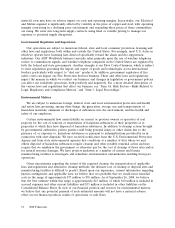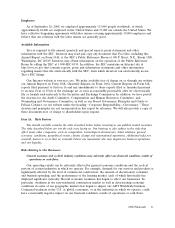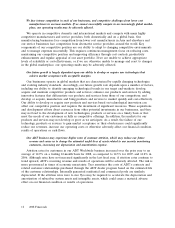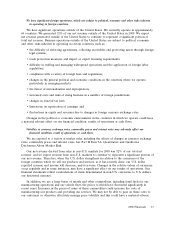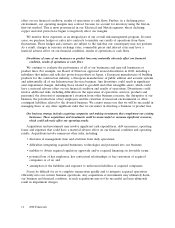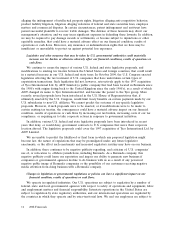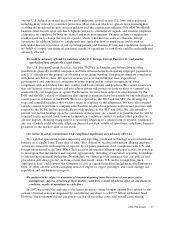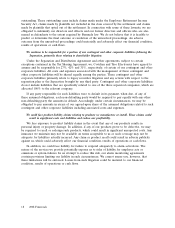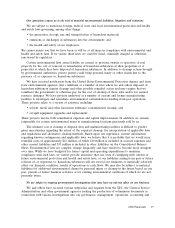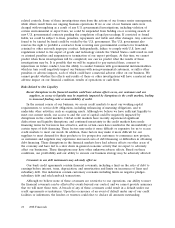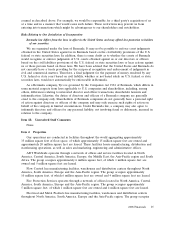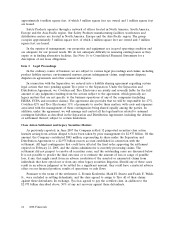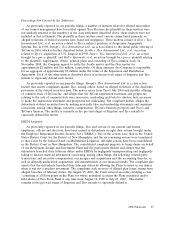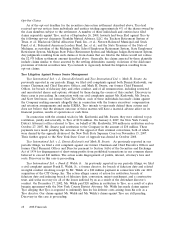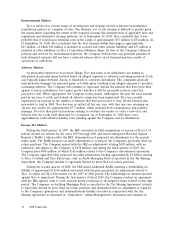ADT 2008 Annual Report Download - page 123
Download and view the complete annual report
Please find page 123 of the 2008 ADT annual report below. You can navigate through the pages in the report by either clicking on the pages listed below, or by using the keyword search tool below to find specific information within the annual report.related controls. Some of these investigations stem from the actions of our former senior management,
while others result from our ongoing business operations. If we or one of our business units were
charged with wrongdoing as a result of any U.S. governmental investigations, including violation of
certain environmental or export laws, we could be suspended from bidding on or receiving awards of
new U.S. governmental contracts pending the completion of legal proceedings. If convicted or found
liable, we could be subject to fines, penalties, repayments and treble and other damages. Any contracts
found to be tainted by fraud could be voided by the U.S. government. The U.S. government also
reserves the right to prohibit a contractor from receiving new governmental contracts for fraudulent,
criminal or other seriously improper conduct. Independently, failure to comply with U.S. laws and
regulations related to the export of goods and technology outside the United States could result in civil
or criminal penalties and suspension or termination of our export privileges. At this time, we cannot
predict when these investigations will be completed, nor can we predict what the results of these
investigations may be. It is possible that we will be required to pay material fines, consent to
injunctions on future conduct, lose the ability to conduct business with governmental instrumentalities,
which in turn could negatively impact our business with non-governmental customers, or suffer other
penalties or adverse impacts, each of which could have a material adverse effect on our business. We
cannot predict whether the effects and results of these or other investigations will have a material and
adverse impact on our financial condition, results of operations or cash flows.
Risks Related to Our Liquidity
Recent disruptions in the financial markets could have adverse effects on us, our customers and our
suppliers, as access to liquidity may be negatively impacted by disruptions in the credit markets, leading
to increased funding costs or unavailability of credit.
In the normal course of our business, we access credit markets to meet our working capital
requirements, to service debt obligations, including refinancing of maturing obligations, and to
undertake other activities, such as acquiring assets. Although we believe we have sufficient liquidity to
meet our current needs, our access to and the cost of capital could be negatively impacted by
disruptions in the credit markets. Global credit markets have recently experienced significant
dislocations and liquidity disruptions, and continued uncertainty in the credit markets have made
financing terms for borrowers less attractive, and in certain cases have resulted in the unavailability of
certain types of debt financing. These factors may make it more difficult or expensive for us to access
credit markets to meet our needs. In addition, these factors may make it more difficult for our
suppliers to meet demand for their products or for prospective customers to commence new projects,
as customers and suppliers may experience increased costs of debt financing or difficulties in obtaining
debt financing. These disruptions in the financial markets have had adverse effects on other areas of
the economy and have led to a slow down in general economic activity that we expect to adversely
affect our businesses. These disruptions may have other unknown adverse affects. Based on these
conditions, our profitability and our ability to execute our business strategy may be adversely affected.
Covenants in our debt instruments may adversely affect us.
Our bank credit agreements contain financial covenants, including a limit on the ratio of debt to
earnings before interest, taxes, depreciation, and amortization and limits on incurrence of liens and
subsidiary debt. Our indentures contain customary covenants including limits on negative pledges,
subsidiary debt and sale/leaseback transactions.
Although we believe none of these covenants are restrictive to our operations, our ability to meet
the financial covenants can be affected by events beyond our control, and we cannot provide assurance
that we will meet those tests. A breach of any of these covenants could result in a default under our
credit agreements or indentures. Upon the occurrence of an event of default under any of our credit
facilities or indentures, the lenders or trustees could elect to declare all amounts outstanding
20 2008 Financials


